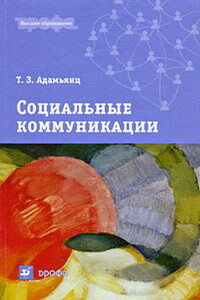Жизнь в стиле Fun. Что делает нас довольными, спокойными и уверенными [заметки]
1
Robert Emmons. Thanks! How the Science of Gratitude Can Make You Happier. New York: Houghton Mifflin Harcourt, 2007.
2
Frederic Luskin et al. A Controlled Pilot Study of Stress Management Training of Elderly Patients with Congestive Heart Failure // Preventive Cardiology. 2002. 5. P. 168–174.
3
Fred B. Bryant et al. Understanding the Processes That Regulate Positive Emotional Experience: Unsolved Problems and Future Directions for Theory and Research on Savoring // International Journal of Wellbeing. 2011. 1 (1). P. 107–126; Bryant et al. Using the Past to Enhance the Present: Boosting Happiness Through Positive Reminiscence // Journal of Happiness Studies. 2005. 6. P. 227–260; Bryant. A Four-Factor Model of Perceived Control: Avoiding, Coping, Obtaining, and Savoring // Journal of Personality. 1989. 57 (4). P. 773–797.
4
Nancy S. Fagley. Appreciation Uniquely Predicts Life Satisfaction Above Demographics, the Big 5 Personality Factors, and Gratitude // Personality and Individual Differences. 2012. 53. P. 59–63.
5
Fred Bryant, Joseph Veroff. Savoring: A New Model of Positive Experience. Mahwah, N.J.: Lawrence Erlbaum Associates, Inc., 2007.
6
Jordi Quoidbach et al. Positive Emotion Regulation and Well-Being: Comparing the Impact of Eight Savoring and Dampening Strategies // Personality and Individual Differences. 2010. 49 (5). P. 368–373.
7
Bryant et al. Understanding the Processes that Regulate Positive Emotional Experience.
8
Brian Toomey, Bruce Ecker. Competing Visions of the Implications of Neuroscience for Psychotherapy // Journal of Constructivist Psychology. 2009. 22. P. 95–140; Ecker, Toomey. Depotentiation of Symptom-Producing Implicit Memory in Coherence Therapy // Journal of Constructivist Psychology. 2008. 21 (2). P. 87–150; Ecker, L. Hulley. Depth Oriented Brief Therapy: How to Be Brief When You Were Trained to Be Deep, and Vice Versa. San Francisco: Jossey-Bass, 1996.
9
Abraham Maslow. The Farther Reaches of Human Nature. New York: Penguin, 1993.
10
Roger Walsh. Lifestyle and Mental Health // American Psychologist. 2011. 66. P. 579–592; Walsh. The Meeting of Meditative Disciplines and Western Psychology // American Psychologist. 2006. 61. P. 227–239.
11
Селигман Мартин. Путь к процветанию. Новое понимание благополучия и счастья. М.: Манн, Иванов и Фербер, 2012; Селигман М. Как научиться оптимизму. Измените взгляд на мир и свою жизнь. М.: Альпина Паблишер, 2017.
12
Christopher Peterson et al. Strengths of Character, Orientations to Happiness, and Life Satisfaction // The Journal of Positive Psychology. 2007. 2 (3). P. 149–156.
13
Nansook Park. Character Strengths: Research and Practice // Journal of College & Character. 2009. 10 (4). P. 1–10.
14
Shauna Shapiro. Mindfulness and Psychotherapy // Journal of Clinical Psychology. 2009. 65. P. 1–6.
15
Barbara Fredrickson. Positivity: Top-Notch Research Reveals the 3 to 1 Ratio That Will Change Your Life. New York: Three Rivers Press, 2009.
16
Соня Любомирски. Психология счастья. Новый подход. СПб: Питер, 2017.
17
Michele Tugade. Positive Emotions and Coping: Examining Dual-Process Models of Resilience, in S. Folkman (ed.), Oxford Handbook of Stress, Health, and Coping. New York: Oxford University Press, 2011. P. 186–199.
18
Todd Kashdan. Curious? Discover the Missing Ingredient to a Fulfilling Life. New York: William Morrow, 2009.
19
Dacher Keltner. Born to Be Good: The Science of a Meaningful Life. New York: W. W. Norton & Company, Inc., 2009.
20
Emmons. Thanks! New York: Houghton Mifflin Harcourt, 2007.
21
Michael McCullough et al. Is Gratitude a Moral Affect? // Psychological Bulletin. 2001. 127 (2). P. 249–266.
22
William A. Cunningham, Tobias Brosch. Motivational Salience: Amygdala Tuning from Traits, Needs, Values, and Goals // Current Directions in Psychological Science. 2012. 21 (1). P. 54–59.
23
Steven M. Southwick, Dennis S. Charney. The Science of Resilience: Implications for the Prevention and Treatment of Depression // Science. 2012. 338. P. 79–82.
24
Я адаптировал диатез-стрессовую модель, которая используется в области медицины, исследованиях стресса и его последствиях.
25
Michael A. Cohn et al. Happiness Unpacked: Positive Emotions Increase Life Satisfaction by Building Resilience // Emotion. 2009. 9. P. 361–368; Greg C. Feldman et al. Responses to Positive Affect: A Self-Report Measure of Rumination and Dampening // Cognitive Therapy and Research. 2008. 32 (4). P. 507–525; Tugade, Fredrickson. Regulation of Positive Emotions: Emotion Regulation Strategies That Promote Resilience // Journal of Happiness Studies. 2007. 8. P. 311–333.
26
Lyubomirsky et al. Pursuing Happiness: The Architecture of Sustainable Change. Review of General Psychology. 2005. 9 (2). P. 111–131.
27
Ed Diener, Micaela Y. Chan. Happy People Live Longer: Subjective Well-Being Contributes to Health and Longevity // Applied Psychophysiology. 2011. 3 (1). P. 1–43; Fredrickson et al. Open Hearts Build Lives: Positive Emotions, Induced Through Loving-Kindness Meditation, Build Consequential Personal Resources // Journal of Personality and Social Psychology. 2008. 95 (5). P. 1045–1062; Y. Chida, A. Steptoe. Positive Psychological Well-Being and Mortality: A Quantitative Review of Prospective Observational Studies // Psychosomatic Medicine. 2008. 70 (7). P. 741–756; S. Pressman, S. Cohen. Does Positive Affect Influence Health? // Psychological Bulletin. 2005. 131. P. 925–971.
28
Это приблизительная оценка. Подробную информацию см. в статьях: Tena Vukasovic et al. Genetic Contribution to the Individual Differences in Subjective Well-Being: A Meta-Analysis // Journal for General Social Issues. 2012. 21. P. 1–17; Southwick, Charney. The Science of Resilience.
29
Есть и четвертый вариант — выйти за пределы своего разума. Вы связываетесь с чем-то божественным, духовным или безусловным, если это важно для вас (для меня это важно). Разумеется, по определению это не является способом управления разумом, поэтому я упоминаю эту возможность, но остаюсь в рамках земного мира в этой книге.
30
Кандель Эрик. В поисках памяти. Возникновение новой науки о человеческой психике. М.: Астрель, 2012; Joseph E. LeDoux. Synaptic Self: How Our Brains Become Who We Are. New York: Penguin Books, 2003.
31
Victoria Ho et al. The Cell Biology of Synaptic Plasticity // Science. 2011. 334. P. 623–628; D. Feldman. Synaptic Mechanisms for Plasticity in Neocortex // Annual Review of Neuroscience. 2009. 32. P. 33–55; Gianluigi Mongillo et al. Synaptic Theory of Working Memory. Science. 2008. 319. P. 1543–1546.
32
Glen O. Gabbard. A Neurobiologically Informed Perspective on Psychotherapy // British Journal of Psychiatry. 2000. 177. P. 117–122; Кандель Э. В поисках памяти.
33
Kandel. A New Intellectual Framework for Psychiatry // American Journal of Psychiatry. 1998. 155. P. 457–469.
34
Eleanor Maguire et al. Navigation-Related Structural Change in the Hippocampi of Taxi Drivers // National Academy of Sciences. 2000. 87. P. 4398–4403.
35
Кроме ствола головного мозга, гипоталамуса и гипофиза многие участки мозга представлены парами: один слева, другой справа, в том числе гиппокамп и островок. К сожалению, представители нейронауки говорят об этих парных органах в единственном числе (например, гиппокамп). Я тоже следую этой традиции.
36
Eileen Luders et al. The Underlying Anatomical Correlates of Long-Term Meditation: Larger Hippocampal and Frontal Volumes of Gray Matter // NeuroImage. 2009. 45. P. 672–678; Sara Lazar et al. Meditation Experience Is Associated with Increased Cortical Thickness // Neuroreport. 2005. 16. P. 1893–1897.
37
Britta Holzel et al. Investigation of Mindfulness Meditation Practitioners with Voxel-Based Morphometry // Social Cognitive and Affective Neuroscience. 2008. 3. P. 55–61; Lazar et al. Meditation Experience.
38
Luders et al. Anatomical Correlates of Long-Term Meditation; Holzel et al. Investigation of Mindfulness Meditation.
39
Jeffery Dusek et al. Genomic Counter-Stress Changes Induced by the Relaxation Response // PLoS One. 2008. 3. e2576.
40
Southwick, Charney. The Science of Resilience.
41
Даты в этом разделе являются приблизительными.
42
Scott W. Emmons. The Mood of a Worm // Science. 2012. 338. P. 475–476.
43
Elizabeth Pennisi. Nervous System May Have Evolved Twice // Science. 2013. 339. P. 391.
44
Ученые называют разные даты в зависимости от метода распределения млекопитающих и приматов по категориям.
45
Shannon McPherron et al. Evidence for Stone-Tool Assisted Consumption of Animal Tissues before 3.39 Million Years Ago at Dikika, Ethiopia // Nature. 2010. 446. P. 857–860; Semaw et al. 2.5-Million-Year-Old Stone Tools from Gona, Ethiopia // Nature. 1997. 385. P. 333–336.
46
Michael Balter. New Light on Revolutions That Weren't // Science. 2012. 336. P. 530–561.
47
Это открытый вопрос. Исследования в поддержку этого утверждения см. здесь: Pierre-Yves Placais, Thomas Preat. To Favor Survival Under Food Shortage, the Brain Disables Costly Memory // Science. 2013. 339. P. 440–442; Linda Palmer, Gary Lynch. A Kantian View of Space // Science. 2010. 328. P. 1487–1488; Tobias Esch, George B. Stefano. The Neurobiology of Stress Management // Neuroendocrinology Letters. 2010. 31 (1). P. 19–39.
48
Pontus Skoglund et al. Origins and Genetic Legacy of Neolithic Farmers and Hunter-Gatherers in Europe // Science. 2012. 336. P. 466–469.
49
Jung-Kyoo Choi, Samuel Bowles. The Coevolution of Parochial Altruism and War // Science. 2007. 318. P. 636–640.
50
Название этого раздела взято из статьи: Roy Baumeister. Bad Is Stronger Than Good // Review of General Psychology. 2001. 5. P. 323–370.
51
Eldad Yechiam, Guy Hochman. Losses as Modulators of Attention: Review and Analysis of the Unique Effects of Losses Over Gains // Psychological Bulletin. 2013. 139 (2). P. 497–518.
52
Baumeister et al. Bad Is Stronger Than Good; Paul Rozin, Edward Royzman. Negativity Bias, Negativity Dominance, and Contagion // Personality & Social Psychology Review. 2001. 5. P. 296–320.
53
Baumeister et al. Bad Is Stronger Than Good; Rozin, Royzman. Negativity Bias.
54
J. S. Morris et al. A Differential Neural Response in the Human Amygdala to Fearful and Happy Facial Expressions // Nature. 1996. 383. P. 812–815.
55
J. S. Morris et al. Conscious and Unconscious Emotional Learning in the Human Amygdala // Nature. 1998. 393. P. 467–470.
56
Daniel Kahneman, Amos Tversky. Prospect Theory: An Analysis of Decision Under Risk // Econometrica. 1979. 47 (2). P. 163–292; Yechiam, Hochman. Losses as Modulators of Attention.
57
John Gottman. Why Marriages Succeed or Fail: And How You Can Make Yours Last. New York: Simon & Schuster, 1995.
58
Fredrickson. Positivity.
59
Rozin, Royzman. Negativity Bias.
60
Rozin, Royzman. Negativity Bias.
61
Baumeister et al. Bad Is Stronger Than Good.
62
Cunningham, Brosch. Motivational Salience; Israel Liberzon et al. Extended Amygdala and Emotional Salience: A PET Activation Study of Positive and Negative Affect // Neuropsychopharmacology. 2003. 28 (4). P. 726–733; Stephan B. Hamann et al. Ecstasy and Agony: Activation of the Human Amygdala in Positive and Negative Emotion // Psychological Science. 2002. 13 (2). P. 135–141; Hugh Garavan et al. Amygdala Response to Both Positively and Negatively Valenced Stimuli // Neuroreport. 2001. 12 (12). P. 2779–2783.
63
Cunningham et al. Neural Correlates of Evaluation Associated with Promotion and Prevention Regulatory Focus // Cognitive, Affective, and Behavioral Neuroscience. 2005. 5 (2). P. 202–211; Andrew J. Calder et al. Neuropsychology of Fear and Loathing // Nature. 2001. 2. P. 353–363.
64
Hugo D. Critchley. Neural Mechanisms of Autonomic, Affective, and Cognitive Integration // Journal of Comparative Neurology. 2005. 493. P. 154–166.
65
Guestavo Morrone Parfitt et al. Moderate Stress Enhances Memory Persistence: Are Adrenergic Mechanisms Involved? // Behavioral Neuroscience. 2012. 126 (5). P. 729–730.
66
E. D. Kirby et al. Basolateral Amygdala Regulation of Adult Hippocampal Neurogenesis and Fear-Related Activation of Newborn Neurons // Molecular Psychiatry. 2012. 17. P. 527–536.
67
Bruce McEwen, Peter Gianaros. Stress- and Allostasis-Induced Brain Plasticity // Annual Review of Medicine. 2011. 62. P. 431–435.
68
McEwen, Gianaros. Stress- and Allostasis-Induced Brain Plasticity; Poul Videbech, Barbaba Ravnkilde. Hippocampal Volume and Depression: A Meta-Analysis of MRI Studies // American Journal of Psychiatry. 2004. 161 (11). P. 1957–1966; Stephanie Campbell et al. Lower Hippocampal Volume in Patients Suffering from Depression: A Meta-Analysis // American Journal of Psychiatry. 2001. 161 (4). P. 598–607.
69
McEwen, Gianaros. Stress- and Allostasis-Induced Brain Plasticity.
70
Tali Sharot. The Optimism Bias: A Tour of the Irrationally Positive Brain. New York: Vintage, 2011.
71
Deborah Kermer et al. Loss Aversion Is an Affective Forecasting Error // Psychological Science. 2006. 17 (8). P. 649–653; Baumeister et al. Bad Is Stronger Than Good; Rozin, Royzman. Negativity Bias.
72
Nadine Gogolla et al. Perineuronal Nets Protect Fear Memories from Erasure // Science. 2009. 325. P. 1258–1261.
73
Daniel L. Schachter. The Seven Sins of Memory: How the Mind Forgets and Remembers. New York: Houghton Mifflin Harcourt Books, 2002.
74
Внутренние силы, а также разные чувства, например несовершенства, в основе которых не лежит обучение и запоминание (другими словами, они не приобретаются), основаны на внутренних, генетически обусловленных характеристиках и тенденциях.
75
Ссылки на утверждения в этом абзаце см. здесь: Baumeister et al. Bad Is Stronger Than Good; Rozin, Royzman. Negativity Bias.
76
Селигман М. Как научиться оптимизму.
77
Селигман М. Как научиться оптимизму.
78
Некоторые виды психотерапии являются исключениями, заслуживающими внимания. К ним относятся фокусирование (Юджин Джендлин. Фокусирование. М.: Корвет, 2016); десенсибилизация и переработка движением глаз, или EMDR (Deborah L. Korn, Andrew M. Leeds. Preliminary Evidence of Efficacy for EMDR Resource Development and Installation in the Stabilization Phase of Treatment of Complex Posttraumatic Stress Disorder // Journal of Clinical Psychology. 2002. 58 (12). P. 1465–1487); когерентная терапия (Toomey, Ecker. Competing Visions; Ecker and Toomey. Depotentiation of SymptomProducing Implicit Memory in Coherence Therapy); широкая аффективная борьба со стрессом (Nicholas Terrier. Broad Minded Affective Coping [BMAC]: A ‘Positive' CBT Approach to Facilitating Positive Emotions // International Journal of Cognitive Therapy. 2010. 31 (1). P. 65–78).
79
Paul D. MacLean. The Triune Brain in Evolution: Role in Paleocerebral Functions. New York: Springer, 1990.
80
Jaak Panksepp. Affective Neuroscience: The Foundations of Human and Animal Emotions. New York: Oxford University Press, 1998; Panksepp. Affective Consciousness: Core Emotional Feelings in Animals and Humans // Consciousness & Cognition. 2005. 14 (1). P. 3080; Jeffrey Burgdorf, Panksepp. The Neurobiology of Positive Emotions // Neuroscience and Biobehavioral Reviews. 2006. 30. P. 173–187.
81
Stephen W. Porges. The Polyvagal Theory: Neurophysiological Foundations of Emotions, Attachment, Communication, and SelfRegulation. New York: W. W. Norton & Company, 2011.
82
Paul Gilbert. Introducing Compassion-Focused Therapy // Advances in Psychiatric Treatment. 2009. 14. P. 199–208.
83
E. Tory Higgins. Beyond Pleasure and Pain // American Psychologist. 1997. 52 (12). P. 1280–1300.
84
Porges. The Polyvagal Theory.
85
Waguih William IsHak et al. Oxytocin's Role in Enhancing Well-Being: A Literature Review // Journal of Affective Disorders. 2011. 130 (1). P. 1–9; Inga D. Neumann. Brain Oxytocin: A Key Regulator of Emotional and Social Behaviours in Both Females and Males // Journal of Neuroendocrinology. 2008. 20. P. 858–865.
86
Pawel K. Olszewski et al. Oxytocin as Feeding Inhibitor: Maintaining Homestasis in Consummatory Behavior // Pharmacology Biochemistry and Behavior. 2010. 97. P. 47–54; Esch, Stefano. The Neurobiology of Stress Management.
87
Hugo D. Critchley, Yoko Nagai. How Emotions Are Shaped by Bodily States // Emotion Review. 2012. 4 (2). P. 163–168.
88
Critchley. Neural Mechanisms.
89
Critchley. Neural Mechanisms.
90
Panksepp. Affective Neuroscience.
91
Ilia Karatsoreos, Bruce McEwen. Psychobiological Allostasis: Resistance, Resilience, and Vulnerability // Trends in Cognitive Sciences. 2011. 15 (12). P. 576–584; Porges. The Polyvagal Theory; Esch, Stefano. The Neurobiology of Stress Management; Panksepp. Affective Consciousness; Panksepp. Affective Neuroscience.
92
Esch, Stefano. The Neurobiology of Stress Management.
93
Craig M. Becker et al. Salutogenesis 30 Years Later: Where Do We Go From Here? // International Electronic Journal Health Education. 2010. 13. P. 25–32.
94
Critchley. Neural Mechanisms.
95
Olszewski et al. Oxytocin as Feeding Inhibitor; Panksepp. Affective Neuroscience.
96
Адаптивный режим с глубоко встроенным ощущением того, что ваши главные потребности уже удовлетворены, нельзя достичь с помощью просветления. На мой взгляд, для этого требуются глубокое понимание, добродетель, любовь и, возможно, милосердие. Но если уничтожить топливо для нейропсихологического «пламени» ненависти и жадности (это буддийские термины), а также страданий в системах избегания, стремления и привязанности, вы проложите путь к очень глубокой связи с религиозной или духовной практикой и к вершинам человеческого потенциала.
97
Douglas P. Fry. Life Without War // Science. 2012. 336. P. 879–884.
98
William W. Seeley et al. Dissociable Intrinsic Connectivity Networks for Salience Processing and Executive Control // Journal of Neuroscience. 2007. 27. P. 2356–2349.
99
Wil Cunningham, Tabitha Kirkland. The Joyful, Yet Balanced Amygdala: Moderated Responses to Positive But Not Negative Stimuli in Trait Happiness // Social Cognitive and Affective Neuroscience. 2013. April 5. e-pub ahead of print.
100
Cunningham, Kirkland. Joyful Amygdala.
101
Cunningham, Brosch. Motivational Salience; Cunningham, Kirkland. Joyful Amygdala.
102
Cunningham et al. Neural Correlates of Evaluation.
103
Дэниел Сигел. Внимательный мозг. М.: Манн, Иванов и Фербер, 2015.
104
Cunningham, Kirkland. Joyful Amygdala.
105
Cunningham, Kirkland. Joyful Amygdala.
106
Douglas Roberts-Wolfe et al. Mindfulness Training Alters Emotional Memory Recall Compared to Active Controls: Support for an Emotional Information Processing Model of Mindfulness // Frontiers in Human Neuroscience. 2012. 6. P. 1–13.
107
Я говорю об адаптивном и реактивном режимах с точки зрения дихотомии. Этот способ соответствует категориальным различиям, которые провели ученые в отношении гомеостатической/аллостатической и симпатической/парасимпатической активности. В сложной и хаотичной биологической структуре животных, в том числе и нас, эти различия размываются — в любой момент могут возникать миксы гомеостатических адаптивных и аллостатических реактивных процессов. Но в целом эти категории, используемые учеными, точны и полезны. На языке теории систем адаптивный и реактивный режимы называются глобальными странными аттракторами.
108
Bruce McEwen, Peter Gianaros. Central Role of the Brain in Stress and Adaptation: Links to Socioeconomic Status, Health, and Disease // Annals of the New York Academy of Sciences. 2010. 1186. P. 190–222.
109
McEwen, Gianaros. Central Role of the Brain in Stress and Adaptation; Сапольски Р. Психология стресса. СПб.: Питер, 2015.
110
Esch, Stefano. The Neurobiology of Stress Management.
111
McEwen, Gianaros. Stress- and Allostasis-Induced Brain Plasticity.
112
McEwen, Gianaros. Central Role of the Brain in Stress and Adaptation; Critchley. Neural Mechanisms.
113
Esch, Stefano. The Neurobiology of Stress Management.
114
Esch, Stefano. The Neurobiology of Stress Management.
115
Byung Kook Lim et al. Anhedonia Requires MC4R-Mediated Synaptic Adaptations in Nucleus Accumbens // Nature. 2012. 487. P. 183–189.
116
Депрессия зачастую выступает реакцией на утрату (например, банкротство). Одной из самых распространенных характеристик является отсутствие удовольствия от ранее приятных вещей (все это связано с системой стремления к награде). В то же время депрессия также возникает после травмы (система избегания), отказа или стыда (система привязанности). Таким образом, я считаю, что депрессия затрагивает все три «операционные системы», порой одну в большей степени, чем остальные.
117
McEwen, Gianaros. Central Role of the Brain in Stress and Adaptation.
118
Esch, Stefano. The Neurobiology of Stress Management; Paul H. Black. The Inflammatory Response is an Integral Part of the Stress Response: Implications for Atherosclerosis, Insulin Resistance, Type II Diabetes, and Metabolic Syndrome X // Brain, Behavior, & Immunity. 2003. 17. P. 350–364; Black. Stress and the Inflammatory Response: A Review of Neurogenic Inflammation // Brain, Behavior, & Immunity. 2002. 16. P. 622–653.
119
McEwen. Stress Adaptation, and Disease: Allostasis and Allostatic Load // Annals of the New York Academy of Sciences. 1998. 840. P. 33–44.
120
McEwen, Gianaros. Central Role of the Brain in Stress and Adaptation.
121
Agnieszka Mika et al. Chronic Stress Impairs Prefrontal Cortex-Dependent Response Inhibition and Spatial Working Memory // Behavioral Neuroscience. 2012. 126 (5). P. 605–619; Ronald S. Duman, George K. Aghajanian. Synaptic Dysfunction in Depression: Potential Therapeutic Targets // Science. 2012. 338. P. 68–72; Daniel J. Christoffel et al. Structural and Synaptic Plasticity in Stress-Related Disorders // Reviews in Neurosciences. 2011. 22 (5). P. 535–549; McEwen. Protective and Damaging Effects of Stress Mediators: Central Role of the Brain // Dialogues in Clinical Neuroscience. 2006. 8 (4). P. 367–381.
122
M. P. Leussis, S. L. Andersen. Is Adolescence a Sensitive Period for Depression? Behavioral and Neuroanatomical Findings from a Social Stress Model // Synapse. 2007. 62 (1). P. 22–30; Q. Wang et al. Alterations of Myelin Basic Protein and Ultrastructure in the Limbic System at the Early Stage of Trauma-Related Stress Disorder in Dogs // Journal of Trauma. 2004. 56 (3). P. 604–610.
123
McEwen, Gianaros. Central Role of the Brain in Stress and Adaptation; Esch, Stefano. The Neurobiology of Stress Management.
124
E. L. van Donkelaar. Stress-Mediated Decreases in Brain-Derived Neurotropic Factor as Potential Confounding Factor for Acute Tryptophan Depletion-Induced Neurochemical Effects // Journal of the European College of Neuropsychopharmacology. 2009. 11. P. 812–821.
125
Jennifer N. Gutsell, Michael Inzlicht. Empathy Constrained: Prejudice Predicts Reduced Mental Simulation of Actions During Observation of Outgroups // Journal of Experimental Social Psychology. 2010. 46. P. 841–845; Xiaojin Xu et al. Do You Feel My Pain? Racial Group Membership Modulates Empathic Neural Responses // Journal of Neuroscience. 2009. 9 (26). P. 8525–8529; Lasana T. Harris, Susan T. Fiske. Social Groups That Elicit Disgust Are Differentially Processed in mPFC // Social Cognitive and Affective Neuroscience. 2007. 2. P. 45–51.
126
Charles Efferson et al. The Coevolution of Cultural Groups and Ingroup Favoritism // Science. 2008. 321. P. 1844–1849.
127
Christopher Boehm. Ancestral Hierarchy and Conflict // Science. 2012. 336. P. 844–847.
128
Fredrickson et al. What Good Are Positive Emotions in Crisis? A Prospective Study of Resilience and Emotions Following the Terrorist Attacks on the U.S. on 9/11/01 // Journal of Personality and Social Psychology. 2003. 84 (2). P. 365–376; Fredrickson, Robert Levenson. Positive Emotions Speed Recovery from the Cardiovascular Sequelae of Negative Emotions // Psychology Press. 1998. 12. P. 191–220.
129
Bryant et al. Understanding the Processes that Regulate Positive Emotional Experience.
130
Fredrickson et al. What Good Are Positive Emotions in Crisis?; Fredrickson, Levenson. Positive Emotions Speed Recovery.
131
Разумеется, вы можете выполнять эту практику чаще.
132
Это тибетская пословица.
133
Fidelma Hanrahan et al. A MetaAnalysis of Cognitive Therapy for Worry in Generalized Anxiety Disorder // Clinical Psychology Review. 2013. 33 (1). P. 120–132; Bunmi O. Olatunji et al. Cognitive-Behavioral Therapy for Obsessive-Complusive Disorder: A Meta-Analysis of Treatment Outcome and Moderators // Journal of Psychiatric Research. 2013. 47 (1). P. 33–41; Rebecca Gould et al. Cognitive Behavioral Therapy for Depression in Older People: A Meta-Analysis and Meta-Regression of Randomized Controlled Trails // Journal of the American Geriatrics Society. 2012. 60 (10). P. 1817–1830; Stefan G. Hofmann et al. The Efficacy of Cognitive Behavioral Therapy: A Review of Meta-Analyses // Cognitive Therapy and Research. 2012. 36 (5). P. 427–440.
134
Esch, Stefano. The Neurobiology of Stress Management.
135
Elizabeth Broadbent et al. A Brief Relaxation Intervention Reduces Stress and Improves Surgical Wound Healing Response: A Randomished Trial // Brain, Behavior, & Immunity. 2012. 26 (2). P. 212–217; Герберт Бенсон. Чудо релаксации. М.: АСТ, 2004.
136
Герберт Бенсон. Чудо релаксации.
137
Brian Rees. Overview of Outcome Data of Potential Mediation Training for Soldier Resilience // Military Medicine. 2011. 176 (11). P. 1232–1242; Dusek et al. Genomic Counter-Stress; Mary Karapetian Alvord, Judy Johnson Grados. Enhancing Resilence in Children: A Proactive Approach // Professional Psychology: Research and Practice. 2005. 36 (3). P. 238–245.
138
Герберт Бенсон. Чудо релаксации.
139
Kent C. Berridge et al. The Tempted Brain Eats: Pleasure and Desire Circuits in Obesity and Eating Disorders // ScienceDirect. 2010. 1350. P. 43–64; Berridge. Wanting and Liking: Observations from the Neuroscience and Psychology Laboratory // Inquiry. 2009. 52 (4). P. 378–398; S. Pecina, Berridge. Hedonic Hot Spot in Nucleus Accumbens Shell: Where Do Mu-Opioids Cause Increased Impact of Sweetness? // Journal of Neuroscience. 2005. 25 (50). P. 11777–11786; Berridge. Food Reward: Brain Substrates of Wanting and Liking // Neuroscience Biobehavioral Review. 1996. 20 (1). P. 1–25.
140
Tugade, Federickson. Regulation of Positive Emotions.
141
Ylva Ostby et al. Mental Time Travel and Default-Mode Network Functional Connectivity in the Developing Brain // Proceedings of the National Academy of Sciences. 2012. 109 (42). P. 16800–16804.
142
Shelly L. Gable et al. What Do You Do When Things Go Right? The Intrapersonal and Interpersonal Benefits of Sharing Positive Events // Journal of Personality and Social Psychology. 2004. 87 (2). P. 228–245; Christopher A. Langston. Capitalizing On and Coping with Daily-Life Events: Expressive Responses to Positive Events // Journal of Personality and Social Psychology. 1994. 67. P. 1112–1125.
143
Jean Decety, Philip L. Jackson. The Functional Architecture of Human Empathy // Behavorial and Cognitive Neuroscience Reviews. 2004. 3. P. 71–100.
144
Susan Folkman, Judith Moskowitz. Positive Affect and the Other Side of Coping // American Psychologist. 2000. 55. P. 647–654.
145
Jorge Moll et al. Human FrontoMesolimbic Networks Guide Decisions About Charitable Donation // Proceedings of the National Academy of Sciences. 2006. 103. P. 15623–15628.
146
Eric Alden Smith. Communication and Collective Action: The Role of Language in Human Cooperation // Evolution and Human Behavior. 2010. 31 (4). P. 231–245; Martin A. Nowak, Karl Sigmund. Evolution of Indirect Reciprocity // Nature. 2005. 437. P. 1291–1298;
Ernst Fehr, Bettina Rockenbach. Human Altruism: Economic, Neural, and Evolutionary Perspectives // Current Opinion in Neurobiology. 2004. 14 (6). P. 784–790; Fehr. Human Behaviour: Don't Lose Your Reputation // Nature. 2004. 432. P. 449–450.
147
Schachter. Adaptive Constructive Processes and the Future of Memory // American Psychologist. 2012. 67 (8). P. 603–613.
148
Schachter. Adaptive Constructive Processes.
149
Спасибо Сэлли Клауф Армстронг за эту метафору.
150
Wulfram Gerstner et al. Theory and Simulation in Neuroscience // Science. 2012. 338. P. 60–65.
151
Panksepp. Affective Neuroscience.
152
Critchley, Nagai. How Emotions Are Shaped by Bodily States.
153
Tom F. Price et al. Embodying Approach Motivation: Body Posture Influences Startle Eyeblink and EventRelated Potential Responses to Appetitive Stimuli // Biological Psychology. 2012. 90. P. 211–217.
154
Price et al. The Emotive Neuroscience of Embodiment // Motivation and Emotion. 2012. 36 (1). P. 27–37; Paula Niedenthal. Embodying Emotion // Science. 2007. 316. P. 1002–1005.
155
Critchley, Nagai. How Emotions Are Shaped by Bodily States.
156
Seligman, Tracy A. Steen. Positive Psychotherapy Progress: Empirical Validation of Interventions // American Psychologist. 2005. 60 (5). P. 410–421.
157
Gerstner et al. Theory and Simulation in Neuroscience.
158
Gretchen Vogel. Can We Make Our Brains More Plastic? // Science. 2012. 338. P. 36–39.
159
Schachter. Adaptive Constructive Processes; Karim Nader. Memory Traces Unbound // Trends in Neurosciences. 2003. 26 (2). P. 65–70; Nader et al. The Labile Nature of Consolidation Theory // Nature. 2000. 1 (3). P. 216–219.
160
Evan Thompson. Mind in Life: Biology, Phenomenology, and the Sciences of Mind. Cambridge, Mass.: Harvard University Press, 2007.
161
Nader et al. The Labile Nature of Consolidation Theory.
162
Nader. Memory Traces Unbound.
163
Mark E. Bouton. Context and Behavioral Processes in Extinction // Learning & Memory. 2004. 11. P. 485–494.
164
Pizzorusso Tommaso. Erasing Fear Memories // Science. 2009. 325. P. 1214–1215.
165
Toomey, Ecker. Competing Vision; Ecker, Toomey. Depotentiation of Symptom-Producing.
166
Точная продолжительность промежутка реконсолидации неизвестна, но она не превышает шести часов.
167
Yan-Xue Xue et al. A Memory Retrieval-Extinction Procedure to Prevent Drug Craving and Relapse // Science. 2012. 336. P. 241–245; Amy L. Milton, Barry J. Everitt. Wiping Drug Memories // Science. 2012. 336. P. 167–168; Daniela Schiller et al. Preventing the Return of Fear in Humans Using Reconcolidation Update Mechanisms // Nature. 2010. 463. P. 49–53; Marie-H. Monfils et al. Extinction-Reconsolidation Boundaries: Key to Persistent Attenuation of Fear Memories // Science. 2009. 324. P. 951–955.
168
Thomas Agren et al. Disruption of Reconsolidation Erases a Fear Memory Trace in the Human Amygdala // Science. 2012. 337. P. 1550–1552.
169
Toomey, Ecker. Competing Visions; Ecker, Toomey. Depotentiation of Symptom Producing.
170
Келли Макгонигал. Сила воли. Как развить и укрепить. М.: Манн, Иванов и Фербер, 2012.
171
Cornelia Kegel et al. Differential Susceptibility in Early Literacy Instruction Through Computer Games: The Role of the Dopamine D4 Receptor Gene (DRD4) // Mind, Brain, and Education. 5. P. 71–78.
172
Schachter. Adaptive Constructive Processes; G. Elliott Wimmer, Dapha Shohamy. Preference by Association: How Memory Mechanisms in the Hippocampus Bias Decisions // Science. 2012. 338. P. 270–273.
173
Кроме того, если вы страдаете биполярным расстройством, будьте осторожнее с интенсивными и продолжительными позитивными эмоциями. Они могут спровоцировать маниакальный приступ. См.: June Gruber. Can Feeling Too Good Be Bad? Positive Emotion Persistence (PEP) in Bipolar Disorder // Current Directions in Psychological Science. 2001. 20 (4). P. 217–221.
174
Judith Herman. Trauma and Recovery: The Aftermath of Violence — from Domestic Abuse to Political Terror. New York: Basic Books, 1997.
175
Peter A. Levine. In an Unspoken Voice: How the Body Releases Trauma and Restores Goodness. Berkeley: North Atlantic Books, 2010.
176
Pat Ogden. Trauma and the Body: A Sensorimotor Approach to Psychotherapy. New York: W. W. Norton & Company, 2006.
177
Bessel A. van der Kolk. Traumatic Stress: The Effects of Overwhelming Experience on Mind, Body, and Society. New York: The Guilford Press, 2006.
178
Kegel et al. Differential Susceptibility in Early Literacy.
179
Bryant et al. Understanding the Processes that Regulate Positive Emotional Experience.
180
Feldman et al. Responses to Positive Affect; Joanne V. Wood et al. Savoring Versus Dampening: Self-Esteem Differences in Regulating Positive Affect // Journal of Personality and Social Psychology. 2003. 85. P. 566–580.
181
Bryant, Veroff. Savoring.
182
Если в ваших отношениях партнер проявлял жестокость или была такая угроза, будьте осторожнее и обратитесь за помощью к профессионалу перед тем, как выполнять практику.
183
Schachter. Adaptive Constructive Processes.
184
Paul Gilbert. The Compassionate Mind: A New Approach to Life's Challenges. Oakland, Calif.: New Harbinger Publications, Inc., 2010.
185
Hamann et al. Ecstasy and Agony; Sergio Paradiso. Cerebral Blood Flow Changes Associated with Attribution of Emotional Valence to Pleasant, Unpleasant, and Neutral Visual Stimuli in a PET Study of Normal Subjects // American Journal of Psychiatry. 1999. 156 (10). P. 1618–1629.
186
Teresa M. Leyro. Distress Tolerance and Psychopathological Symptoms and Disorders: A Review of the Empirical Literature among Adults // Psychological Bulletin. 2010. 136 (4). P. 576–600.
187
Critchley. Neural Mechanisms.
188
Critchley, Nagai. How Emotions Are Shaped by Bodily States; Porges. The Polyvagal Theory.
189
См. прекрасную книгу: Thich Nhat Hanh. Being Peace. Berkeley: Parallax Press, 2005.
190
Panksepp. Affective Consciousness.
191
Panksepp. Affective Consciousness; Panksepp. Affective Neuroscience.
192
Pressman, Cohen. Does Positive Affect Influence Health?
193
Fagley. Appreciation Uniquely Predicts Life Satisfaction; Michael G. Adler, Fagley. Appreciation: Individual Differences in Finding Value and Meaning as a Unique Predictor of Subjective Well-Being // Journal of Personality. 2005. 73. P. 79–114; Emmons. Thanks!; Emmons. McCullough. Counting Blessings Versus Burdens: An Experimental Investigation of Gratitude and Subjective Well-Being in Daily Life // Journal of Personality and Social Psychology. 2003. 84 (2). P. 377–389.
194
Gilbert. The Compassionate Mind.
195
Andreas Meyer-Lindenberg. Impact of Prosocial Neuropeptides on Human Brain Function // Progress in Brain Research. 2008. 170. P. 463–470; Daniele Viviani, Ron Stoop. Opposite Effects of Oxytocin and Vasopressin on the Emotional Expression of the Fear Response // Progress in Brain Research. 2008. 170. P. 207–218.
196
Markus Heinrichs et al. Social Support and Oxytocin Interact to Suppress Cortisol and Subjective Responses to Psychosocial Stress // Biological Psychiatry. 2003. 54. P. 1389–1398.
197
Decety, Margarita Svetlova. Putting Together Phylogenetic and Ontogenetic Perspectives on Empathy // Developmental Cognitive Neuroscience. 2011. 2 (1). P. 1–24.
198
E. B. Keverne et al. Beta-Endorphin Concentrations in Cerebrospinal Fluid of Monkeys Are Influenced by Grooming Relationships // Psychoneuroendocrinology. 1989. 14. P. 155–161.
199
Panksepp. Affective Consciousness.
200
Olga M. Klimecki et al. Functional Neural Plasticity and Associated Changes in Positive Affect after Compassion Training // Cerebral Cortex. 2012. 6. doi: 10.1093/cercor/ bhs142. PII: bhs142.
201
Kristin D. Neff. SelfCompassion, Self-Esteem, and Well-Being // Social and Personality Psychology Compass. 2011. 5 (1). P. 1–12; Neff. Self-Compassion: An Alternative Conceptualization of a Healthy Attitude Toward Onself // Self and Identity. 2003. 2 (2). P. 85–101.
202
Neff. Self-Compassion, SelfEsteem, and Well-Being; Mark R. Leary et al. Self-Compassion and Reactions to Unpleasant Self-Relevant Events: The Implications of Treating Oneself Kindly // Journal of Personality. 2007. 92. P. 887–904; Christopher Germer. The Mindful Path to Self-Compassion: Freeing Yourself from Destructive Thoughts and Emotions. New York: The Guilford Press, 2009.
203
Samuel Bowles. Warriors, Levelers, and the Role of Conflict in Human Social Evolution // Science. 2012. 336. P. 876–878; Bowles. Did Warfare among Ancestral HunterGatherers Affect the Evolution of Human Social Behaviors? // Science. 2009. 324. P. 1293–1298; Choi, Bowles. The Coevolution of Parochial Altruism and War.

Книга известных ученых-нейропсихологов – невиданное ранее сочетание психологии, неврологии и техник самосовершенствования. Опираясь на новейшие достижения науки, авторы проникают в самые глубины человеческого мозга и показывают его взаимосвязь с психикой. С помощью этой книги вы сможете повысить эффективность работы своего мозга, развить лучшие личные качества и тем самым улучшить свою жизнь. В книге много нестандартных практических рекомендаций, поясняющих иллюстраций, эффективных упражнений, увлекательных примеров.

О чем эта книга:О смысле жизни.Во что верить и где её (веру) искать.О людях феноменальной силы, ума, воли.Вся, правда, о ясновидцах, экстрасенсах...О том, как нами манипулируют и обманывают.Как жить, не болея и оставаться работоспособным до старости.Что такое секс и любовь.О ложных и истинных жизненных целях.О экологически чистом сельском хозяйстве.Что такое «Национальная идея»?Об образовании и воспитании.Об экологии и экономике и о многом другом здесь написано простым и понятным языком. Книга рассчитана на широкий круг читателей.

Пособие представляет собой адаптированное изложение ключевых теоретических и практических аспектов семиосоциопсихологической концепции, разработанной в рамках российской академической науки выдающимся ученым Т.М. Дридзе. В самом определении этой концепции заключена ее суть: междисциплинарность, исследовательский поиск и возможности кругозора «на стыке наук». В пособии предлагаются методы и подходы, знакомящие с комплексными социально-диагностическими и социально-проектными технологиями, направленными на совершенствование коммуникативных навыков людей, на реализацию задач социально ориентированного управления коммуникационными процессами.

Есть особый вид телесных ощущений, которым является наше чувство ситуации. Они смутны, неотчетливы, их трудно выразить словами. Но именно эти неясные ощущения служат своеобразным камертоном. Фокусируясь на этих ощущениях, шаг за шагом пытаясь прояснить их, можно вызывать реальные изменения в состоянии человека и качестве его жизни.Юджин Джендлин, известный американский психотерапевт, психолог и философ предлагает метод работы с такими неотчетливыми ощущениями — фокусирование. В книге подробно рассматриваются его основные приемы, а также проводятся параллели с другими направлениями психотерапии.Книга безусловно обогатит арсенал психотерапевтов и других специалистов “помогающих” профессий.

Лин Коуэн — доктор философии, область ее интересов — юнгианский аналитический подход, который она практикует в течение 25 лет. Занимала пост директора Межрегионального центра юнгианского анализа, президента Межрегионального общества юнгианских аналитиков, профессора в Центре обучения практической психологии (штат Миннесота). Является автором ряда книг по юнгианской психологии. Доктор Коуэн читает лекции в США, Европе и Южной Америке.Родилась в Нью-Йорке, долгое время прожила в штате Миннесота, сейчас живет и работает в Хьюстоне, штат Техас.Ее книга «Мазохизм» выдержала несколько изданий.

В книге рассказывается история главного героя, который сталкивается с различными проблемами и препятствиями на протяжении всего своего путешествия. По пути он встречает множество второстепенных персонажей, которые играют важные роли в истории. Благодаря опыту главного героя книга исследует такие темы, как любовь, потеря, надежда и стойкость. По мере того, как главный герой преодолевает свои трудности, он усваивает ценные уроки жизни и растет как личность.

В книге рассказывается история главного героя, который сталкивается с различными проблемами и препятствиями на протяжении всего своего путешествия. По пути он встречает множество второстепенных персонажей, которые играют важные роли в истории. Благодаря опыту главного героя книга исследует такие темы, как любовь, потеря, надежда и стойкость. По мере того, как главный герой преодолевает свои трудности, он усваивает ценные уроки жизни и растет как личность.

«Книга, которой нет» – это не художественное произведение, автор которого борется за признание, овации, премии и прочую блестящую мишуру. У этой книги другая цель – сделать так, чтобы в мире стало меньше серых жизней. Чтобы незаурядные люди вспоминали, что они талантливы, и начинали творить. Чтобы те, кто отчаялся, получили поддержку и увидели свет в конце тоннеля.В любом случае читайте – я желаю вам удачи, даже если вы просто нашли где-то эту книгу, потому что именно для тех, кто решительно настроен на работу по улучшению себя и своего окружающего мира, и написана «Книга, которой нет».

Современный мир – это цитадель порядка или царство хаоса? Мы появляемся на свет, чтобы стать вольными художниками Бытия или следовать универсальным Правилам? Отвечая на сложнейшие вопросы мироустройства, доктор Питерсон мастерски сплетает постулаты древних учений, великие литературные произведения и откровения современной науки и философии. Лобстеры непреклонны и тверды, защищая свою территорию. Шимпанзе кровожадны и склонны к иерархии. Кошки дружелюбны, но живут сами по себе. Не теми ли путями идут люди, балансируя между добротой и озлобленностью, великодушием и обидой, благородством и мстительностью? «12 правил жизни» – 12 бездонно простых истин, мудрые законы существования, низвергающие стереотипы и облагораживающие разум и дух читателя. Джордан Питерсон – клинический психолог, философ, профессор психологии Университета Торонто.

Может ли одна монетка сделать человека богатым? Конечно, нет, скажете вы. Но если добавить еще одну? И еще? И еще? В какой-то момент количество перейдет в качество. А теперь представьте, что одно крошечное изменение кардинально меняет всю жизнь. Звучит фантастически! Но, как и в случае с монетками, срабатывает эффект сложного процента. И вот уже маленькое, но регулярное действие привело к большим результатам. Атомные привычки – маленькие изменения, в которых скрыта огромная мощь! Вы давно пытаетесь измениться, но не получается.